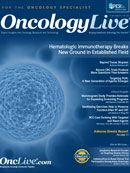Publication
Article
Oncology Live®
Lymphoma Research Focuses on Targeting Genetic Drivers
Author(s):
During the past three decades, our treatment approach to lymphoma has been based on the underlying histological and clinical features of the disease.
Anas Younes, MD
Chief, Lymphoma Service
Memorial Sloan-Kettering
Cancer Center
During the past three decades, our treatment approach to lymphoma has been based on the underlying histological and clinical features of the disease. For example, patients with diffuse large B-cell lymphoma are treated in a way that is different from those with mantle cell lymphoma— but all patients with diffuse large B-cell lymphoma are treated the same way.1
Today, the World Health Organization (WHO) classifies lymphoma into at least 30 major distinctive types. While this classification has improved the accuracy and consistency of the histological diagnosis of lymphoma, it has had little impact on advancing therapy or improving lymphoma cure rates.
Even though the number of histological subtypes has increased, a recent genetics analysis demonstrated that these histological subtypes are not homogeneous.2 For example, although diffuse large B-cell lymphoma biopsy specimens may look the same under the microscope, they can be completely different at the genetic levels (Figure).
Therefore, basing treatment decisions on lymphoma histological features results in the grouping of tumors with different molecular characteristics in one category. It is not surprising that in any given lymphoma subtype a fraction of patients are likely to benefit from certain therapy, while many others will have treatment-resistant tumors. As a result, physicians frequently administer therapy to patients that provides little benefit, while exposing them to the toxicity of therapy.
Selected Targeted Agents Under Study for Lymphoma
BKM120
- Oral agent that inhibits PI3K activity
- Phase II safety and efficacy study
- Enrolling patients with relapsed/refractory diffuse large B-cell lymphoma, mantle cell lymphoma, or follicular lymphoma
IPI-145
- Capsule that inhibits PI3K activity
- Phase I dosing study
- Enrolling patients with advanced hematologic malignancies (with certain exceptions)
Memorial Sloan-Kettering Cancer Center Clinical Trials. For more information, visit www.mskcc.org/cancer-care/adult/ lymphomas/clinical-trials
The Lymphoma Service at Memorial Sloan- Kettering is actively involved in the development of new treatment strategies that can be tailored for individual patients based on the genetic composition of their lymphoma tumors. This approach will lead to the ability to offer different treatment to patients with the same histologic subtype of their lymphoma, potentially offering higher response to therapy while minimizing treatment-related toxicity.3
Updating, Diversifying, Collaborating
To achieve this outcome, we are updating our clinical trial designs and diversifying our portfolio to offer a variety of treatment options that may target specific cancer-promoting machinery. We are also incorporating biomarker analysis of patients’ tumors to help in matching patients with specific therapies.
Moreover, we are also establishing major collaborations with our basic science colleagues in the Sloan-Kettering Institute with the goal of rapidly translating their recent scientific discoveries into novel treatment strategies for lymphoma. Such collaborations include screening lymphoma cells for new therapeutic targets, designing new mechanism-driven combination strategies, and exploring new immune therapy approaches that take advantage of the patient’s own immune system. We are also developing new chemotherapy-free treatment programs.
Examples of such efforts include clinical trials targeting the phosphatidylinositol 3-kinase (P13K) pathway at different levels, including BKM120, IPI-145, and idelalisib, combination drugs that target histone deacetylase and P13K, small-molecule inhibitors that target the B-cell receptor signaling pathway (Btk and Syk inhibitors), and small molecules that target PKC, in addition to new antibody-drug conjugates either alone or in combination.
Figure. Gene Expression Patterns in Lymphomas
Courtesy Bill Branson/National Cancer Institute
A DNA microarray analysis compares gene expression levels in Burkitt and diffuse large B-cell lymphomas. Green patterns indicate genes overexpressed in normal cells compared with lymphoma cells, while red patterns show genes overexpressed in lymphoma cells compared with normal cells.
References
- Younes, A. Beyond chemotherapy: new agents for targeted treatment of lymphoma [published online ahead of print December 14, 2010]. Nat Rev Clin Oncol. 2011;8(2):85-96.
- Lenz G, Staudt LM. Aggressive lymphomas. N Engl J Med. 2010;362(15):1417-1429.
- Younes A, Berry DA. From drug discovery to biomarker-driven clinical trials in lymphoma [published online ahead of print September 11, 2012]. Nat Rev Clin Oncol. 2012;9(11):643-653.










